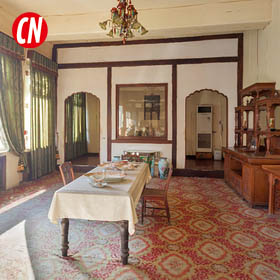The Palace Museum - Gate of Supreme Harmony And Square
Taihe Gate and Square
Taihe Gate was the main gate leading to the Three Great Halls area, where the Ming Dynasty emperors used to gather for the government. There is a square in front of Taihe Gate, where the Jinshui River crosses the square from west to east, and the Jinshui Bridge over the river is opposite to the Outer Jinshui Bridge in front of Tiananmen Square.
Through the solemn Meridian Gate (Wumen 午门), there is a palace-style gate tower in front of you, which is the Gate of Supreme Harmony (Taihe Gate 太和门), the main entrance to the outer court of the Forbidden City.
Ancient Chinese palace architectures follow a “Three-Courts-and-Five-Gates System”. Gate of Supreme Harmony, the Taihe gate, is one of the “five gates” (the other four are Damingmen, Tiananmen, Duanmen, Wumen). In the Ming dynasty, Taihe Gate was the place where the emperors used to attend early morning conferences, and the Emperor Shunzhi of the Qing dynasty was also enthroned here, which shows its importance.
Taihe Gate was built in the Ming Dynasty in 1420, and was destroyed by fire several times, most recently during the Guangxu period. The existing Taihe Gate was rebuilt in 1889, the fifteenth year of Guangxu’s reign.
Taihe Gate was built on top of a white marble Xu-mi base, with a facade of nine rooms and a door height of 23.8 meters. It has yellow glazed tiles on top of the Double-eaved saddle roof. In the Ming Dynasty, this gate was called the Fengtian Gate and the Huangji Gate, and was renamed the Taihe Gate only when the Qing Dynasty was under the reign of Emperor Shunzhi. There are two bronze lions in front of the gate, which were cast in the Ming Dynasty.
Manywhere Trivia:
There are a square stone cabinet and a stone pavilion behind the two stone lions in front of Taihe Gate, no one has yet figured out what they are for.
There is a square between Taihe Gate in the north and Wumen Gate in the south, there are also Zhendu Gate and Zhaode Gate on the left and right sides of Taihe Gate, both leading to the Square of Supreme Harmony. On the east and west sides of Taihe Gate Square, there are Xihe Gate and Xiehe Gate, which leads to the Hall of Martial Valor (Wuying Hall 武英殿) area and the Hall of Literary Brilliance (Wenhua Hall 文华殿) area.
The Inner Golden Water River runs from west to east across Taihe Gate Square, with five white marble bridges: the Inner Golden Water Bridge, which lies side by side with the Outer Golden Water Bridge in front of Tiananmen Square. The Inner Golden Water River plays an extremely important role, it not only adds vitality to the Forbidden City, but also is the city’s main drainage system. It can provide water to extinguish the fire, too.
Through the Taihe Gate, the main entrance to the Forbidden City, you will enter the core area of the Palace Museum: the Three Great Halls area (Taihe Hall, Zhonghe Hall, Baohe Hall). Let’s continue to the next part of our tour:

The Palace Museum - Three Halls of the Outer Court
Taihe,Zhonghe and Baohe Halls
The Three Great Halls is the center of the outer court of the Forbidden City, also known as the first three halls, referring to Taihe Hall, Zhonghe Hall and Baohe Hall. They are the venues for grand ceremonies, the imperial examinations, imperial weddings, and other activities.
The Palace Museum Series
- The Palace Museum / The Forbidden City
- The Palace Museum - Meridian Gate And Square
- The Palace Museum – Gate of Supreme Harmony And Square
- The Palace Museum - Three Halls of the Outer Court
- The Palace Museum - Three Palaces of the Inner Court
- The Palace Museum - Hall of Martial Valor
- The Palace Museum - Hall of Mental Cultivation
- The Palace Museum - Hall for Ancestral Worship / The Clock Gallery
- The Palace Museum - Palace of Tranquil Longevity Area / The Treasure Gallery
- The Palace Museum - Six Palaces of West Road
- The Palace Museum - Six Palaces of East Road
- The Palace Museum - The Imperial Garden
- The Palace Museum - Gate of Divine Prowess
- The Palace Museum - The Corner Tower And Moat
Tags:
Related
National Mosque Of Malaysia360
Largest Mosque in ASEANOtaru Canal360
Red Brick Warehouses and Gas LightsSant'Andrea della Valle360
Where the Opera Tosca Took PlaceFort Canning Park360
Urban Hilltop Historic BatteryPeople in Night City 2360
The Mysterious Guest StarMerdeka Square360
Rise of the Malaysian BannerTokugawake Reidai360
Mausoleum of Shogun Ieyasu and HidetadaKyushu National Museum360
One of Japan's 4 National MuseumsFuji Omuro Sengen Jinja Shrine360
The Oldest Shrine in Mt.FujiHofburg Palace360
Massive Austrian Palace ComplexThe Palace Museum - Hall of Mental Cultivation360
Yangxin PalaceSchonbrunn Palace And Garden360
Empress Sisi's Summer Residence





























No comments yet, post the first one!